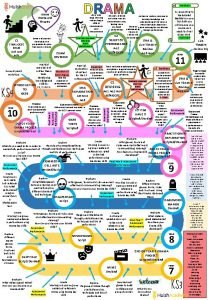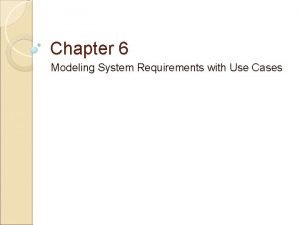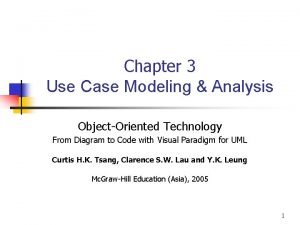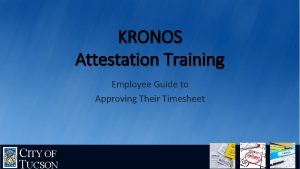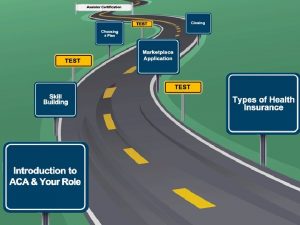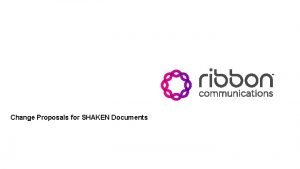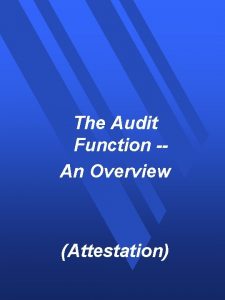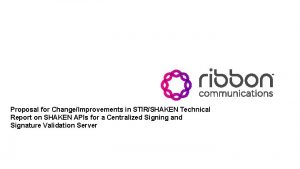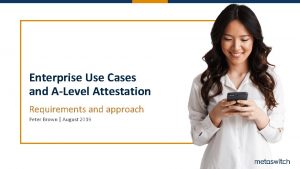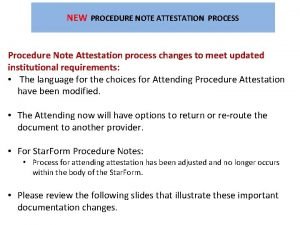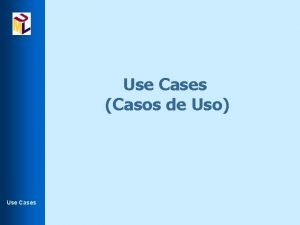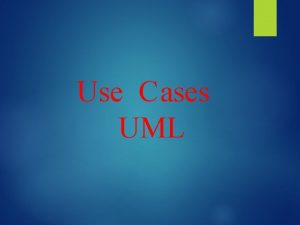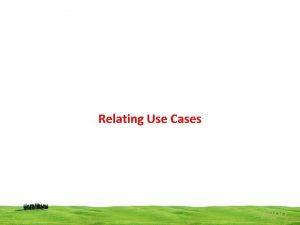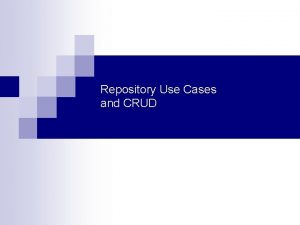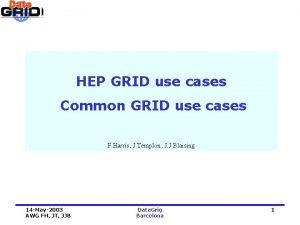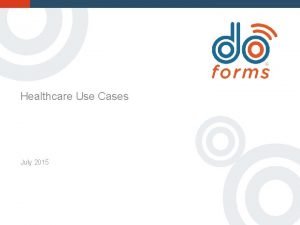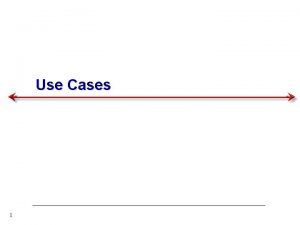Enterprise Use Cases and ALevel Attestation Additional Use


















- Slides: 18

Enterprise Use Cases and A-Level Attestation Additional Use Cases and Central TN Database approach Peter Brown | August 2019 Based on IPNNI-2019 -00071 R 002

Restating the problem } Service providers must be able to sign with A-level attestation calls from an enterprise which is using calling numbers from a different service provider. } To deliver this, we explore an approach involving an authoritative source of: › TN-to-Enterprise association › Delegated authority by TN Providers. Metaswitch Networks | Proprietary and confidential | © 2019 | 2

Requirements statements } These requirements have come from the user community as well as industry partners – enterprise customers, carriers, etc: › Carriers need a consistent set of rules that they will apply for signing for enterprises. › Carriers need assurances about an enterprise’s delegated authority to use TNs. › The access and retrieval of Enterprises’ assigned TN information must be secured. › The Originating Service Provider has to be responsible for signing the call (for traceability and accountability). • Hence Enterprise self-signing is excluded from this approach. › › › Avoid multiple Identity Headers in signed calls. Minimise the impact on Enterprises. Simplify the complexity for Carriers. Enterprises should have the ability to use toll-free numbers as their calling numbers. Enterprises should have the ability to port their numbers from one carrier to another. Metaswitch Networks | Proprietary and confidential | © 2019 | 3

Updated Use Cases Metaswitch Networks | Proprietary and confidential | © 2019 | 4

Use Case 1: Single TNSP, Single OSP } Minor update: } The PASSpor. T is signed using an STI-Certificate with a TNAuthlist containing a single SPC with a value assigned to OSP AB Metaswitch Networks | Proprietary and confidential | © 2019 | 5

Use Case 8: Call Center – a dynamic variant of Use Case 2 } Enterprise may be using a Business Process Outsourcing Contact Center for outbound call campaigns › Contact Center has no TNs natively assigned › Contact Center receives a list of TNs when the campaign is defined. } Number blocks may be fast-changing } OSP choice may be fast-changing (due to LCR, say) Metaswitch Networks | Proprietary and confidential | © 2019 | 6

Use Case 9: LNP update } Not a call scenario } Any solution approach must ensure that A-level attestion can be maintained for an Enterprise when it has ported a number from one TNSP to another Metaswitch Networks | Proprietary and confidential | © 2019 | 7

Central TN Database Approach Metaswitch Networks | Proprietary and confidential | © 2019 | 8

Central TN Database activity on TN assignment 1. Enterprise requests TNs CTND 2. Carrier informs CTND › Issues to be addressed: • Enterprise ID must be unique – assigned and managed by the CTND • Posted TNs should be unique (except 8 xx) therefore CTND responses must include error cases. POST /TN_ENTERPRISE_LIST • • • TN range Enterprise ID Expiry date Carrier A SPID Carrier A cert URL Carrier A signature 3. Carrier provides TNs to Enterprise 2 Carrier A OSP TNSP 1 Enterprise Metaswitch Networks | Proprietary and confidential | © 2019 | 9 3

Central TN Database activity on receipt of SIP INVITE a) Enterprise sends INVITE CTND b) Carrier requests from CTND › GET /TN_STATUS • • (mutual TLS) Query TN & Enterprise ID b c) CTND responds with › › Expiry date Owning TNSP SPID CTND cert URL CTND signature d) Carrier can verify that a valid TNSP has provided TN to Enterprise. Carrier sends INVITE with attestation level A PASSpor. T Metaswitch Networks | Proprietary and confidential | © 2019 | 10 Note: (b) and (c) could operate on cached/subscribed information c Carrier A d OSP TNSP a Enterprise

Use Cases Revisited with CTND Metaswitch Networks | Proprietary and confidential | © 2019 | 11

Use Case 2: TNSP A, OSP B } Carrier ‘A’ is one of many possible Originating SPs, and also one of many TN Providers } Enterprise has purchased TNs from multiple TNSP, including Carrier ‘A’ } Enterprise has trunks to multiple carriers, including Carrier ‘B’, for outbound call origination } For each number range provided to the Enterprise, a TN Provider will have submitted an entry to the Central TN Database › Optionally, these will have been signalled to the Central TN Database Client Service at each carrier that is registered with the Database } When the Enterprise sends an INVITE to an Originating SP › The OSP queries their Central TN Database Client Service to confirm that the number has been registered as “in use” by that Enterprise by a valid TN Provider Metaswitch Networks | Proprietary and confidential | © 2019 | 12

Use Case 2: TNSP A, OSP B 1. Initial TN assignment to Enterprise from Carrier A acting as TNSP CTND TNSP A informs CTND about Enterprise TN assignment. 2. Enterprise is able to initiate A-level attested calls through OSP B uses CTND information to ensure that Enterprise has permission to use TN. 1 Carrier B OSP Carrier A TNSP 1 2 Metaswitch Networks | Proprietary and confidential | © 2019 | 13 Enterprise

Use Case 4: 8 xx calls } Enterprise originates calls using 8 xx numbers } Enterprise may split their outbound traffic between multiple carriers, including Carrier ‘A’, and switch often to minimize cost and improve reliability } 8 xx numbers used by the Enterprise may be resporg’d by one owner, but carried across multiple Service Providers } Implications for Central TN Database › More than one Enterprise can use one 8 xx number › There can be multiple Enterprise IDs associated with each 8 xx number in the database Metaswitch Networks | Proprietary and confidential | © 2019 | 14

Use Case 8: Call Center } Enterprise may be using a Business Process Outsourcing Contact Center for outbound call campaigns › › Contact Center has no TNs natively assigned Contact Center receives a list of TNs when the campaign is defined. } Number blocks may be fast-changing } OSP choice may be fast-changing (due to LCR, say) } Enterprise must inform their TNSP that TNs have been assigned (and when unassigned) to Contact Center } TNSP must pass this information to CTND Metaswitch Networks | Proprietary and confidential | © 2019 | 15

Use Case 8: Call Center CTND 1. Initial TN assignment to Enterprise from Carrier B acting as TNSP 2. Enterprise provides a subset of TNs to Call Center 3. Enterprise informs TNSP 4 1 Carrier A OSP Carrier B TNSP 4. TNSP informs CTND 1 5. Call Center is able to initiate Alevel attested calls through its preferred OSP(s). 5 3 Enterprise 2 Call Center Metaswitch Networks | Proprietary and confidential | © 2019 | 16

Use Case 9: Central TN Database updates due to LNP } TNSPs must inform the CTND about LNP updates within number ranges that have been assigned to enterprises } The source carrier (from which a TN has been ported) must specify the remaining range of numbers that has been assigned to an enterprise which is still owned by that carrier } The destination carrier (to which a TN has been ported) must specify that this TN is assigned to the enterprise and is now owned by this carrier PUT /TN_ENTERPRISE_UPDATE TN/TN-list ported-out Enterprise ID Expiry date Carrier A SPID Carrier A cert URL Carrier A signature CTND POST /TN_ENTERPRISE_LIST TN/TN-list ported-in Enterprise ID Expiry date Carrier B SPID Carrier B cert URL Carrier B signature Carrier B Carrier A OSP TNSP Metaswitch Networks | Proprietary and confidential | © 2019 | 17 OSP TNSP

Proposed next steps } Reach agreement on incorporating content into IPNNI-00071 R 002 › Use Cases › Central TN Database approach } Associated issues to be resolved › Enterprise ID administration › Error cases to be returned from CTND API requests • In particular, whether DNs will be enforced as unique in the CTND Metaswitch Networks | Proprietary and confidential | © 2019 | 18
 Edexcel alevel history
Edexcel alevel history Aqa a level physics data sheet
Aqa a level physics data sheet Drama alevel
Drama alevel Aqa alevel psychology
Aqa alevel psychology Criminal cases vs civil cases
Criminal cases vs civil cases Use case narratives
Use case narratives Use case description
Use case description Attestation fimo
Attestation fimo Audit vs assurance
Audit vs assurance Medical student attestation
Medical student attestation Attestation mensuelle cmg caf
Attestation mensuelle cmg caf Graham gal
Graham gal Attestation vs audit
Attestation vs audit Ssp.post matric.karnataka.gov.in/cis/
Ssp.post matric.karnataka.gov.in/cis/ Kronos attestation
Kronos attestation Doh 5088 form
Doh 5088 form P-attestation-indicator
P-attestation-indicator Attestation audit definition
Attestation audit definition Pattestation
Pattestation


